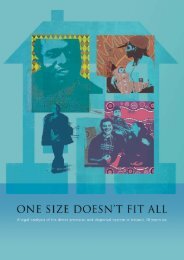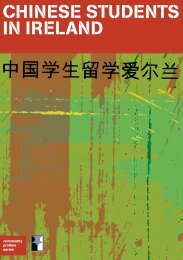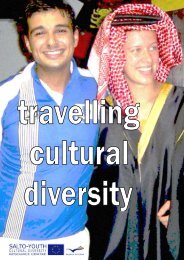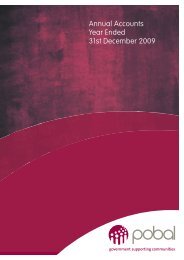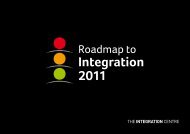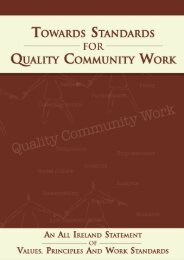Intercultural Education in the Post-Primary School - National Council ...
Intercultural Education in the Post-Primary School - National Council ...
Intercultural Education in the Post-Primary School - National Council ...
Create successful ePaper yourself
Turn your PDF publications into a flip-book with our unique Google optimized e-Paper software.
CLASSROOM PLANNING 4attitudes; unfavourable stories engendermore negative attitudes. Bias <strong>in</strong> textbookscan be conveyed <strong>in</strong> a number of ways. Thefour most common forms of bias are<strong>in</strong>accuracy, stereotyp<strong>in</strong>g, omissions anddistortions and biased language usage.Develop<strong>in</strong>g <strong>the</strong> ability to recognise bias is akey skill for help<strong>in</strong>g students becomecritical readers for life. This skill should befostered not just <strong>in</strong> relation to read<strong>in</strong>gtextbooks but also <strong>in</strong> relation to us<strong>in</strong>g <strong>the</strong><strong>in</strong>ternet, films, videos and o<strong>the</strong>r media.There are a grow<strong>in</strong>g number of<strong>in</strong>tercultural education packs available <strong>in</strong>Ireland as well as resources <strong>in</strong> <strong>the</strong> relatedareas of human rights, conflict and peaceand development education. TheDevelopment <strong>Education</strong> Unit ofDevelopment Co-operation Ireland (Dept.of Foreign Affairs) produces an annualguide to available resources that may be ofuse to teachers. Pavee Po<strong>in</strong>t also produceslists of resources that promote equality anddiversity <strong>in</strong> schools. (See <strong>the</strong> resource listfor an extensive list of resources.)In many cases teachers do not need to lookbeyond <strong>the</strong>ir exist<strong>in</strong>g texts and curriculumdocuments to f<strong>in</strong>d <strong>the</strong> necessary resources.Where exist<strong>in</strong>g resources offer limitedopportunities to explore difference, topromote equality or to develop criticalth<strong>in</strong>k<strong>in</strong>g skills, this can, <strong>in</strong> itself be turned<strong>in</strong>to a resource. Through question<strong>in</strong>g whatperspectives are miss<strong>in</strong>g and how <strong>the</strong> samematerial or event might be presented orviewed differently or though compar<strong>in</strong>gtexts with o<strong>the</strong>r possible source materials,teachers can use limited material to developpupils’ capacity to th<strong>in</strong>k about <strong>the</strong> way <strong>in</strong>which <strong>in</strong>formation is presented to <strong>the</strong>m.The follow<strong>in</strong>g checklist will be of use <strong>in</strong>choos<strong>in</strong>g and us<strong>in</strong>g texts or resources foruse <strong>in</strong> <strong>the</strong> class. These issues apply equallyto fictional and factual resources. Forexample, questions regard<strong>in</strong>g <strong>the</strong>representation of a diversity of ethnicgroups apply as much to an Englishlanguage reader as <strong>the</strong>y do to a Geographytextbook.The resource should make realisticassumptions about <strong>the</strong> backgroundknowledge of <strong>the</strong> learners.• Does it choose examples, stories orillustrations, which are predom<strong>in</strong>antlydrawn from one culture, or does it usestories, examples and illustrations thatmight be familiar to different groups ofchildren from <strong>the</strong>ir home life?• If <strong>the</strong> material is biased, how can <strong>the</strong>teacher mediate this to bridge <strong>the</strong> gapbetween <strong>the</strong> start<strong>in</strong>g po<strong>in</strong>t of <strong>the</strong> pupiland that of <strong>the</strong> resource?The resource should realistically andpositively reflect a diversity of ethnicgroups <strong>in</strong> its text, illustrations andexercises.• Are <strong>the</strong>re sufficient representations ofmembers of m<strong>in</strong>ority ethnic groups usedto ensure that <strong>the</strong> dom<strong>in</strong>ance of <strong>the</strong>majority ethnic group <strong>in</strong> images ofIreland <strong>in</strong> everyday life is balanced?• Are <strong>the</strong> images chosen to reflectaccurately people’s current daily lives?• Are m<strong>in</strong>ority ethnic groups or peoplefrom o<strong>the</strong>r countries represented <strong>in</strong>stereotypical ways (for example, areAfricans largely depicted as liv<strong>in</strong>g <strong>in</strong>poverty and <strong>in</strong> need of aid, are NativeAmericans depicted largely <strong>in</strong> terms offrontier wars and struggles, are membersof m<strong>in</strong>ority groups depicted largely <strong>in</strong>terms of <strong>the</strong>ir feasts or festivals)?• Are particular groups represented only<strong>in</strong> terms of <strong>the</strong>ir membership of thatgroup (for example, are Travellersrepresented <strong>in</strong> ‘ord<strong>in</strong>ary’ mathsquestions or stories, or do <strong>the</strong>y onlyappear when m<strong>in</strong>ority issues are underdiscussion)?<strong>Intercultural</strong> <strong>Education</strong> <strong>in</strong> <strong>the</strong> <strong>Post</strong>-<strong>Primary</strong> <strong>School</strong> 39








